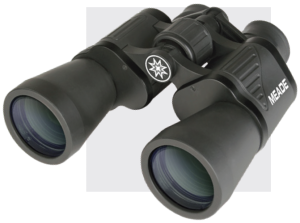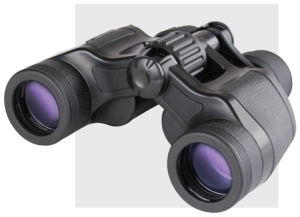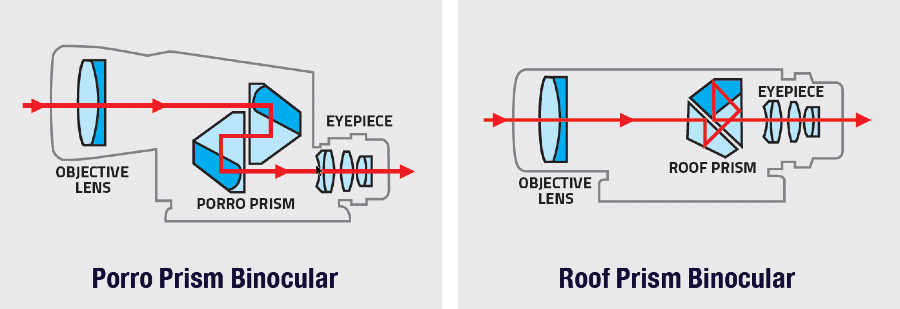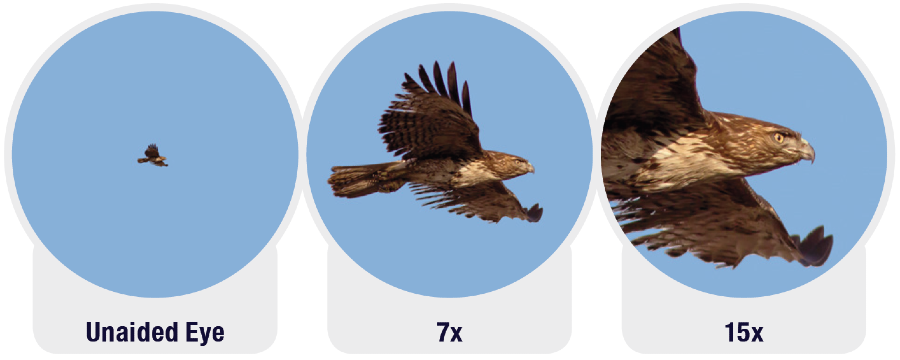While many binocular brands look about the same, there are often important differences in performance from one manufacturer to another. The information in this article will allow you to choose the right binocular for your intended applications, budget, and personal preferences. Every Meade binocular, from the least expensive model on up, incorporates quality optical components, durable optical housings, and precision mechanical components for years of high-performance observing. It is this Meade attention to detail and intimate knowledge of optical design fabrication that is perhaps your best assurance of all.
Binoculars are available in hundreds of specifications and with a multitude of different features, but all share the same three basic components.
Objective Lenses
The main (objective) lenses of a binocular serve to collect light, thereby enabling the high-resolution observation of distant objects. In a quality binocular, each objective lens typically is manufactured of two separate glass elements, the so-called crown and flint elements. The refractive specifications of these elements permit the objective lens to form images free of false colors.
Prisms
Since the objective lenses form images that are both upside-down and reversed left-for-right, prisms are required to invert the primary image. Most commonly, binoculars utilize either porro prisms or roof prisms for this purpose. Porro prisms give binoculars their familiar zig-zag profile, while roof prisms permit a straight-line design. Either type of prism, properly manufactured, yields excellent optical results.
Eyepieces
The ocular, or eyepiece, design included with a binocular has important performance implications. While the most basic function of an eyepiece is to magnify the image formed by the objective lens, in fact the eyepiece also largely determines the binocular's field of view, edge-of-field image resolution, and other characteristics listed below. Eyepieces are manufactured from two to five glass elements.
With the knowledge of the basic components of a binocular, it is now possible to understand the technical terminology that will enable selection of the right binocular for you.
Binocular Specifications
Binoculars are classified as, for example, 7 x 35mm — read "seven by thirty-five millimeters." In this case, the binocular is of 7-power ("7x") and includes objective lenses of 35mm (about 1.38") diameter. Other binoculars might range from a tiny 3 x 14mm to giant battleship binoculars that are 40 x 178mm. The "WA" designation after a binocular specification, such as 7 x 35mm WA, refers to the wide-angle design of the binocular's eyepieces. Wide-angle eyepieces can increase a binocular's visual field of view by as much as 60%.
Magnification
Magnification, or power, is perhaps the most misunderstood term in binocular optics. While higher powers can be useful, power by itself does not increase the level of observable detail. Image resolution is a function of objective lens diameter, not of binocular power. Higher powers result in images that are less bright and in a binocular that is more difficult to hold steady in the user's hands. Powers of 7x or 8x are by far the most popular among regular binocular users. Binoculars with magnifications above about 12x are generally not recommended for use without a tripod.

A binocular's field of view is measured in degrees of arc or as field-width (in feet) at 1,000 years distance. Example: Meade's 8 x 32mm Rainforest Pro binocular has a field of view of 8.1 degrees, which is 429 feet wide for an object 1,000 years distant from the observer, yielding a field of view specification of 426 feet at 1,000 yards. Other non-wide-angle binoculars have fields of view of perhaps 270 feet to 320 feet at 1,000 years. Depending somewhat on the observer's intended applications, wide-angle binoculars are generally well worth the relatively modest additional cost involved.
Lens Coatings
An uncoated optical glass lens or prism reflects about 10% of the light incident on one of its surfaces, allowing only about 90% of the light to pass through. Standard coatings of magnesium fluoride (MgF2) applied to the lens and prism surfaces reduce the level of reflected light to about 4%, and with substantially reduced ghost images of bright objects. More sophisticated multi-coatings further reduce reflected light and can result in total light transmission through a lens or prism of 99% or more. Some Meade models are fully multi-coated with perhaps the most advanced multi-coatings available, permitting 99+% light transmission and extremely high image contrast.
Eye Relief
Binocular users who wear eyeglasses for near- or far-sightedness may remove their glasses while observing — the binocular can fully correct for these eye defects. Observers who suffer from astigmatism, however, may need to wear their glasses to maintain sharp views through the binocular. In this latter case, choosing a binocular with longer eye relief will enable easier binocular observing with eyeglasses.
Binocular Models
Although the nomenclature associated with binoculars varies somewhat from manufacturer to manufacturer, the majority of binocular manufacturers use the classifications described here:

Compact binoculars utilize roof prisms to invert the image and usually are styled to form-fit comfortably in the observer's hands. Objective lenses are typically 25mm in diameter or less. As their name implies, compact binoculars, while larger than mini binoculars, are relatively small and easy to carry. For sporting events, as a gift item, or as a general-purpose travel binocular, compacts are extremely popular, because, again, for all but the most advanced applications, compacts provide a good trade-off between weight, performance, and cost.

Most binoculars referred to as general purpose are standard porro prism models. The typically larger objective lens apertures, 35mm or more, of these models enable bright, high-contrast images on the entire range of viewing subjects, from sporting events, to long-range animal observation in the wild, to high-resolution study of a bird's feather structure. A moderately priced, high-quality, standard porro prism model is a binocular for almost any observing application. Standard porro prism binoculars are available in a wide range of specifications and price points.

Zoom binoculars offer the convenience of zooming to higher or lower powers at the touch of a finger.

Professional-level binocular resolution and performance are generally reserved for standard roof prism models. Designed usually for advanced applications, such as for serious birders, standard roof prism binoculars are typically of 35mm objective lens aperture or larger, include sleek, straight-line roof prism styling, and incorporate the finest optical glasses, multi-coatings, and multi-element eyepieces. The result is bright, extremely sharp, high-resolution images throughout the field of view, with a level of image fidelity unobtainable in lesser binoculars. Although premium-grade standard roof prism binoculars are not inexpensive, they are usually treasured for a lifetime.



